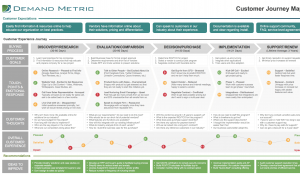Customer Journey Mapping
- Aug 21, 2013 6:31 AM
- Completed
WIth the development of our Customer Experience Management (CEM) methodology & tool-kit in development, a lot of our focus recently has been on the development of a tool to help members create customer journey maps. Sometimes called Customer Experience Maps, customer journey maps are all about communicating how your customers think and feel on an emotional level while they are interacting with your organization.
To build an effective journey map, it is critical that you conduct primary research with both qualitative (interviews, focus groups) and quantitative (surveys, data analysis) methods to identify your customer's pain points and level of satisfaction as they engage with your brand though all the different channels you communicate through, as well as those touch-points you don't own, such as social media conversations.
In the end, its all about distilling your research of the 'real-world', not 'ideal' customer experience into something actionable that can be rallied around in your organization. Many companies blow up their customer journey maps onto very large posters and hang them up on the walls in most or all departments in the organization to break down departmental silos and focus on putting the customer in the spotlight.
Following are a few common items to include or consider as you build a journey map, and don't worry, we will be publishing a great new template in a couple of weeks to help you further:
DURATION - most journey maps are based on a timeline such as a purchase process or the common customer path.
STAGES - you can organize your journey map around buying stages or other key intervals.
TOUCH-POINTS - these are the various communication points your customers has with you or about you.
MOMENTS OF TRUTH - coined by Scandinavian Air's CEO, these the touch-points that customers deem a highly important.
CUSTOMER EFFORT - consider measuring and showing how difficult it is for a customer to acheive their goal in terms of effort.
GOALS - what is your customer trying to accomplish at this stage of their journey?
EXPECTATIONS - what does your customer expect at this stage? Could this process be simplified or easier for them?
DATA SOURCES - be sure to include the source of the data your are depicting on your journey map.
ACTIONS - include the customers behaviors or what they are doing physically at each stage in the process.
FEELINGS - customer journey maps are all about demonstrating the emotions of your customers, positive and negative.
SENSATIONS - what are your customers seeing, hearing, touching, etc.
THOUGHTS - what thoughts are racing through your typical customer's minds at this stage in the process?
EXPERIENCE - how would they rate the overall experience for this touch-point or stage? Pleasant, satisfactory, or upsetting?
RECOMMMENDATIONS - journey maps need to be actionable to show what changes need to be made to improve the experience.
PERSPECTIVE - it can be helpful to create different journey maps based on buyer persona, customer segments or other relevant filters.
CONNECTION - how does this experience connect to your value proposition or brand promise? Is there a gap here?
We will follow up this post with a link to a new Customer Journey Map Tool very shortly. Let us know if you have built a journey map before and can add any other ideas here! Stay tuned!
UPDATE: our Customer Journey Map tool has been published!
Use this tool to visually depict the customer journey across 5 phases: Discovery/Research, Evaluation/Comparison, Decision/Purchase, Implementation, and Support/Renew.


2 Responses
re; MOT
Just a small correction "Moments of Truth" was defined by Richard Normann when consulting at SAS Carlzon never attributed this to the real brains behind it.
Hi Jesse,
This sounds like a great methodology. When will it be ready?